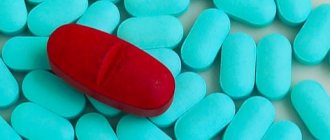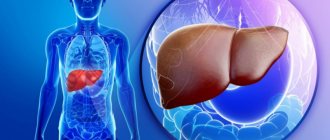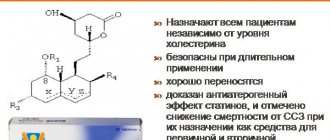Choosing a manufacturer
Which manufacturer is better? Atorvastatin is produced by several Russian pharmaceutical companies, Kanonpharma, Vertex. is Israeli. How do the means differ? The difference between them lies in production technology, degree of purification and the quality of additional components of the drug.
The active ingredient is the same everywhere – atorvastatin. Atorvastatin Teva received good recommendations. The manufacturer pays special attention to the purification of both the main and additional components, which minimizes the risk of developing side effects described in the annotation for the drug.
An analogue is a medicine that contains the active ingredient of the original drug, but differs in the list of additional components. Below are the most well-known Atorvastatin substitutes.
Atoris
Atoris is one of the best analogs of Atorvastatin, which has received good recommendations from both doctors and patients. Produced by KRKA (Slovenia). The active ingredient is atorvastatin, which blocks the production of cholesterol by liver cells. Atoris belongs to the third generation drugs.
It is distinguished by high efficiency and a small number of side symptoms. You need to take the product once a day in the evening. The medicine is offered in the form of tablets with a dosage of 5/10/20/40 mg, packaged in 30/60/90 tablets per package. The cost of the product varies: from 300 to 900 rubles.
The leading contraindication for use is liver disease (acute and chronic form). If you have hepatitis or other liver problems, you should consult your doctor before starting therapy. During administration, it is necessary to monitor the level of transaminases in the blood serum.
No ads 1
Action of Atorvastatin
After oral administration, the tablets bind to coenzyme A receptors at the site where the special enzyme HMG-CoA reductase is attached, blocking its production. This enzyme is present in the liver and is directly involved in the production of cholesterol. In parallel, the drug works in a different direction - the process of converting intermediate products into cholesterol is inhibited. The results are:
- reducing the presence of cholesterol in cells;
- accelerating the breakdown of existing cholesterol into the most harmful low-density lipoproteins.
It is these lipoproteins, at elevated levels, that cause the development of atherosclerosis. Taking the medicine helps reduce the rate of progression of the disease. At the same time, “good” high-density cholesterol increases. It removes fats from cholesterol plaques and helps process them in the liver. Symptoms of the disease decrease, and the risk of cardiac death also decreases. Other actions of the drug:
WE RECOMMEND THE ARTICLE!
Flax oil replenishes the body's needs for Omega-3 and vitamin E. Read more >>
- improvement of the condition of the vascular wall;
- optimization of blood flow;
- antioxidant effect.
Metabolites of the drug are processed in the liver, from where they are excreted naturally with bile. The difference between Rosuvastatin is that its residues are excreted unchanged in the feces.
Liprimar
The drug is offered in the form of tablets with a dosage of 10/20 mg. A package may contain 14–100 pills. This is very convenient if the patient is just starting to take this Atorvastatin substitute. A small package of 14 tablets helps to assess the tolerability of the drug and decide on the possibility of further use. You need to take the tablet in the recommended dosage in the evening.
Liprimar is manufactured by the German pharmaceutical company Pfizer.
Contraindications:
- any trimester of pregnancy;
- breastfeeding period;
- diabetes mellitus, impaired glucose tolerance.
Important! Liprimara is prescribed with caution in the presence of chronic allergies and liver pathologies.
When diagnosing atherosclerosis in patients over 70 years of age, the dosage is calculated individually. Self-administration of the drug by elderly patients is strictly prohibited. The cost of the medicine is 500–1000 rubles.
Buy Atorvastatin tablets p.o 20 mg No. 30 in pharmacies
Atorvastatin Buy Atorvastatin in pharmacies DOSAGE FORMS film-coated tablets 20 mg
MANUFACTURERS Canonpharma production (Russia)
GROUP Lipid-lowering drugs - HMG-CoA reductase inhibitors
COMPOSITION Active ingredient: atorvastatin.
INTERNATIONAL NON-PROPENTED NAME Atorvastatin
SYNONYMS Atomax, Atorvastatin-OBL, Atorvastatin-LEKSVM, Atorvastatin-Teva, Atoris, Lipitor, Lipoford, Liprimar, Liptonorm, TG-tor, Torvacard, Tulip
PHARMACOLOGICAL ACTION A lipid-lowering drug from the group of statins. A selective competitive inhibitor of HMG-CoA reductase, an enzyme that converts 3-hydroxy-3-methylglutaryl coenzyme A into mevalonic acid, which is a precursor of sterols, including cholesterol. Triglycerides (TG) and cholesterol in the liver are incorporated into very low-density lipoproteins (VLDL), enter the blood plasma and are transported to peripheral tissues. Low-density lipoproteins (LDL) are formed from VLDL through interaction with LDL receptors. Atorvastatin reduces cholesterol and lipoprotein levels in the blood plasma by inhibiting HMG-CoA reductase, cholesterol synthesis in the liver and increasing the number of “liver” LDL receptors on the cell surface, which leads to increased uptake and catabolism of LDL. Reduces the formation of LDL, causes a pronounced and persistent increase in the activity of LDL receptors. Reduces LDL levels in patients with homozygous familial hypercholesterolemia, which usually does not respond to treatment with lipid-lowering drugs. Reduces the level of total cholesterol by 30-46%, LDL - by 41-61%, apolipoprotein B - by 34-50% and TG - by 14-33%; causes an increase in the level of HDL cholesterol (high density lipoprotein) and apolipoprotein A. Dose-dependently reduces the level of LDL in patients with homozygous hereditary hypercholesterolemia, resistant to therapy with other lipid-lowering drugs. Pharmacokinetics. Absorption is high. The maximum concentration in blood plasma is achieved after 1-2 hours, the maximum concentration in women is 20% higher, the area under the curve/concentration, time (AUC) is 10% lower; the maximum concentration in patients with alcoholic cirrhosis is 16 times, AUC is 11 times higher than normal. Food slightly reduces the rate and duration of drug absorption (by 25% and 9%, respectively), but the reduction in LDL cholesterol is similar to that when using Atorvastatin without food. The concentration of Atorvastatin when used in the evening is lower than in the morning (by approximately 30%). A linear relationship was revealed between the degree of absorption and the dose of the drug. Bioavailability - 12%, systemic bioavailability of inhibitory activity against HMG-CoA reductase - 30%. Low systemic bioavailability is due to first-pass metabolism in the mucous membrane of the gastrointestinal tract and during the “first pass” through the liver. The average volume of distribution is 381 l, binding to plasma proteins is 98%. Metabolized primarily in the liver under the influence of cytochrome CYP3A4, CYP3A5 and CYP3A7 with the formation of pharmacologically active metabolites (ortho- and parahydroxylated derivatives, beta-oxidation products). In vitro, ortho- and parahydroxylated metabolites have an inhibitory effect on HMG-CoA reductase comparable to that of Atorvastatin. The inhibitory effect of the drug on HMG-CoA reductase is approximately 70% determined by the activity of circulating metabolites. Excreted in bile after hepatic and/or extrahepatic metabolism (not subject to pronounced enterohepatic recirculation). The half-life is 14 hours. Inhibitory activity against HMG-CoA reductase lasts for about 20-30 hours due to the presence of active metabolites. Less than 2% of the dose taken orally is determined in the urine. Not excreted during hemodialysis.
INDICATIONS FOR USE Used: in combination with diet to reduce elevated levels of total cholesterol, cholesterol/LDL, apolipoprotein B and triglycerides and increase HDL cholesterol in patients with primary hypercholesterolemia, heterozygous familial and non-familial hypercholesterolemia and combined (mixed) hyperlipidemia (types Pa and lib according to Fredrickson); in combination with diet for the treatment of patients with elevated serum triglyceride levels (Fredrickson type IV) and patients with dysbetalipoproteinemia (Fredrickson type III) in whom dietary therapy does not provide an adequate effect; to reduce total cholesterol and LDL/LDL cholesterol levels in patients with homozygous familial hypercholesterolemia, when diet therapy and other non-pharmacological treatments are not effective enough.
CONTRAINDICATIONS Hypersensitivity to the components of the drug; active liver disease or increased activity of liver enzymes of unknown origin (more than 3 times the upper limit of normal); liver failure (severity according to the Child-Pug classification A and B) pregnancy; lactation period; age under 18 years (efficacy and safety have not been established). With caution: alcohol abuse, history of liver disease, severe electrolyte imbalance, endocrine and metabolic disorders, arterial hypotension, severe acute infections (sepsis), uncontrolled epilepsy, major surgical interventions, trauma, skeletal muscle diseases. Use during pregnancy and lactation: Atorvastatin is contraindicated for use during pregnancy and lactation (breastfeeding). It is not known whether Atorvastatin is excreted in breast milk. Considering the possibility of adverse events in infants, if it is necessary to use the drug during lactation, the issue of stopping breastfeeding should be decided. Women of reproductive age should use adequate contraception during treatment. Atorvastatin should only be prescribed to women of reproductive age if the likelihood of pregnancy is very low and the patient is informed of the possible risk of treatment to the fetus.
SIDE EFFECTS From the nervous system - more often than 2% - insomnia, dizziness; less often 2% - headache, asthenia, malaise, drowsiness, nightmares, paresthesia, peripheral neuropathy, amnesia, emotional lability, ataxia, facial paralysis, hyperkinesis. migraine, depression, hypoesthesia, loss of consciousness. From the senses: less often 2% - amblyopia, tinnitus, dry conjunctiva, impaired accommodation, hemorrhage in the retina, deafness, glaucoma, parosmia, loss of taste, taste perversion. From the cardiovascular system: more often than 2% - chest pain; less often 2% - palpitations, symptoms of vasodilation. orthostatic hypotension, increased blood pressure, phlebitis, arrhythmia, angina pectoris. From the hematopoietic system: less than 2% - anemia, lymphadenopathy, thrombocytopenia. From the respiratory system: more often 2% - bronchitis, rhinitis; less often 2% - pneumonia, dyspnea, exacerbation of bronchial asthma, nosebleeds. From the digestive system: more often 2% - nausea; less than 2% - heartburn, constipation or diarrhea, flatulence, gastralgia, abdominal pain, decreased or increased appetite, dry mouth, belching, dysphagia. vomiting, stomatitis, esophagitis, glossitis, erosive and ulcerative lesions of the oral mucosa, gastroenteritis, hepatitis, biliary colic, cheilitis, duodenal ulcer, pancreatitis, cholestatic jaundice, liver dysfunction, rectal bleeding, melena, bleeding gums, tenesmus . From the musculoskeletal system: more often than 2% - arthritis; less often 2% - leg muscle cramps, bursitis, tenosynovitis. myositis, myopathy, arthralgia, myalgia, rhabdomyolysis, torticollis, muscle hypertonicity, joint contractures. From the genitourinary system: more often than 2% - urogenital infections, peripheral edema; less often 2% - dysuria (including pollakiuria, nocturia, urinary incontinence or urinary retention, imperative urge to urinate), nephritis, hematuria, vaginal bleeding, nephrourolithiasis, metrorrhagia, epididymitis. decreased libido, impotence. ejaculation disorder. From the skin: more often than 2% - alopecia, xeroderma, increased sweating, eczema, seborrhea, ecchymosis, petechiae. Allergic reactions: less often 2% - skin itching, skin rash, contact dermatitis, rarely - urticaria, angioedema, facial swelling, photosensitivity, anaphylaxis, exudative erythema multiforme (including Stevens-Johnson syndrome), toxic epidermal necrolysis (syndrome) Lyell). Laboratory indicators: less than 2% - hyperglycemia, hypoglycemia, increased serum CPK, albuminuria. Other: less than 2% - weight gain, gynecomastia, mastodynia, exacerbation of gout.
INTERACTIONS The risk of myopathy during treatment with other drugs in this class is increased with concomitant use of cyclosporine, fibrates, erythromycin, azole antifungals, and nicotinic acid. With simultaneous oral administration of the drug and a suspension containing magnesium and aluminum hydroxide, the concentrations of Atorvastatin in the blood plasma decreased by approximately 35%, but the degree of reduction in cholesterol/LDL levels did not change. With simultaneous use of the drug does not affect the pharmacokinetics of antipyrine (phenazone), therefore, interaction with other drugs metabolized by the same cytochrome isoenzymes is not expected. With simultaneous use of colestipol, plasma concentrations of Atorvastatin were reduced by approximately 25%. However, the lipid-lowering effect of the combination of Atorvastatin and colestipol was superior to that of each drug alone. With repeated administration of digoxin and the drug at a dose of 10 mg, the equilibrium concentrations of digoxin in the blood plasma did not change. However, when using digoxin in combination with the drug at a dose of 80 mg/day. digoxin concentration increased by approximately 20%. Patients receiving digoxin in combination with the drug should be monitored. With simultaneous use of the drug and erythromycin (500 mg 4 times / day) or clarithromycin (500 mg 2 times / day), which inhibit cytochrome P450 3A4, an increase in plasma concentration was observed. With simultaneous use of the drug (10 mg 1 time / day) and azithromycin (500 mg 1 time / day), the concentration of the drug in the blood plasma did not change. Atorvastatin did not have a clinically significant effect on the plasma concentration of terfenadine, which is metabolized mainly by cytochrome P450 3A4; in this regard, it seems unlikely that Atorvastatin can significantly affect the pharmacokinetic parameters of other cytochrome P450 ZA4 substrates. When coadministered with an oral contraceptive containing norethindrone and ethinyl estradiol, significant increases in the AUC of norethindrone and ethinyl estradiol by approximately 30% and 20%, respectively, were observed. This effect should be taken into account when choosing an oral contraceptive for a woman receiving Atorvastatin. Concomitant use with drugs that reduce the concentration of endogenous steroid hormones (including cimetidine, ketoconazole, spironolactone) increases the risk of a decrease in endogenous steroid hormones (caution should be exercised). When studying the interaction of the drug with warfarin and cimetidine, no signs of clinically significant interaction were found. With simultaneous use of 80 mg and amlodipine 10 mg, the pharmacokinetics of the drug at steady state did not change. There were no clinically significant adverse interactions between the drug and antihypertensive drugs. The simultaneous use of the drug with protease inhibitors, known as cytochrome P450 3A4 inhibitors, was accompanied by an increase in the concentration of the drug in the blood plasma. No pharmaceutical incompatibilities are known.
METHOD OF APPLICATION AND DOSAGE Before prescribing the drug, the patient must be recommended a standard lipid-lowering diet, which he must continue to follow throughout the entire period of therapy. The initial dose is on average 10 mg 1 time / day. The dose varies from 10 to 80 mg 1 time/day. The drug can be taken at any time of the day with food or regardless of meal time. The dose is adjusted based on baseline LDL/C cholesterol levels, goals of therapy, and individual response. At the beginning of treatment and/or during dose increases of Atorvastatin, it is necessary to monitor plasma lipid levels every 2-4 weeks and adjust the dose accordingly. Primary hypercholesterolemia and mixed hyperlipidemia. as well as type 111 and IV according to Fredrickson. In most cases, a dose of 10 mg of the drug once a day is sufficient. A significant therapeutic effect is observed after 2 weeks, as a rule, and the maximum therapeutic effect is usually observed after 4 weeks. With long-term treatment, this effect persists. Homozygous familial hypercholesterolemia. Prescribed at a dose of 80 mg (4 tablets of 20 mg) 1 time per day. The use of the drug in patients with renal failure and kidney disease does not affect the level of Atorvastatin in the blood plasma or the degree of reduction in cholesterol/LDL during its use, so no change in the dose of the drug is required. In case of liver failure, the dose must be reduced. When using the drug in elderly patients, there were no differences in safety, effectiveness, or achievement of lipid-lowering therapy goals compared to the general population.
OVERDOSE Treatment: there is no specific antidote, symptomatic therapy is carried out. Hemodialysis is ineffective.
SPECIAL INSTRUCTIONS Before starting therapy, the patient must be prescribed a standard hypocholesterol diet, which he must follow during the entire treatment period. The use of HMG-CoA reductase inhibitors to reduce blood lipid levels can lead to changes in biochemical parameters reflecting liver function. Liver function should be monitored before starting therapy, 6 weeks, 12 weeks after starting the drug and after each dose increase, and periodically, for example, every 6 months. An increase in the activity of liver enzymes in the blood serum may be observed during therapy. Patients who experience elevated enzyme levels should be monitored until enzyme levels return to normal. If alanine aminotransferase (ALT) or aspartic aminotransferase (AST) values are more than 3 times the upper acceptable limit, it is recommended to reduce the dose of the drug or discontinue treatment. The drug should be used with caution in patients who abuse alcohol and/or have liver disease. Active liver disease or persistent increases in aminotransferase activity of unknown origin are contraindications to the use of Atorvastatin. Treatment with the drug may cause myopathy. The diagnosis of myopathy (muscle pain and weakness in combination with an increase in creatine phosphokinase (CPK) activity more than 10 times the upper limit of normal) should be considered in patients with widespread myalgia, muscle soreness or weakness, and/or a marked increase in CPK activity. Patients should be warned that they should immediately tell their doctor if they experience unexplained muscle pain or weakness if they are accompanied by malaise or fever. Therapy should be discontinued in the event of a marked increase in CPK activity or in the presence of confirmed or suspected myopathy. The risk of myopathy during treatment with other drugs in this class was increased with concomitant use of cyclosporine, fibrates, erythromycin, niacin, or azole antifungals. Many of these drugs inhibit cytochrome P450 3A4-mediated metabolism and/or drug transport. Atorvastatin is biotransformed by CYP 3A4. When prescribing Atorvastatin in combination with fibrates, erythromycin, immunosuppressive agents, azole antifungals or nicotinic acid in lipid-lowering doses, the expected benefits and risks of treatment should be carefully weighed and patients should be regularly monitored to detect muscle pain or weakness, especially during the first months of treatment and during periods of increasing the dose of any drug. In such situations, periodic determination of CPK activity can be recommended, although such monitoring does not prevent the development of severe myopathy. When using the drug, like other drugs of this class, cases of rhabdomyolysis with acute renal failure caused by myoglobinuria have been described. Therapy should be temporarily discontinued or completely discontinued if signs of possible myopathy occur or if there is a risk factor for the development of renal failure due to rhabdomyolysis (eg, severe acute infection, hypotension, major surgery, trauma, severe metabolic, endocrine and electrolyte disturbances, and uncontrolled seizures). Before initiating therapy, an attempt should be made to control hypercholesterolemia through adequate dietary therapy, increased physical activity, weight loss in obese patients, and treatment of other conditions. Patients should be warned to seek immediate medical attention if they experience unexplained muscle pain or weakness, especially if accompanied by malaise or fever. Impact on the ability to drive a car and operate machinery. No adverse effects of the drug on the ability to drive a car or operate machinery have been reported.
STORAGE CONDITIONS Store in a dry place, protected from light, out of reach of children, at a temperature not exceeding 25 C.
Torvacard
Torvacard tablets
An analogue of Atorvastatin from the Czech manufacturer, ZENTIVA. Included in the group of third generation statins. The suggested dosage of tablets is 10/20/40 mg. The package contains 30/90 tablets. The cost of the product is 400–1200 rubles. The drug is especially effective in the following cases:
- the need to control and normalize cholesterol levels after surgery on the hearts and blood vessels;
- treatment of severe stages of atherosclerosis (in this case, combined with fibrates and bile acid sequestrants).
After surgery, the duration of the course of use is one to three months, for atherosclerosis - for the rest of life. According to the instructions for use, you need to take the tablet in the recommended dosage once a day.
Indications for use
The indications for all hyperlipidemic drugs are the same; there is no difference in this matter. Based on the name and action, the main indication is high cholesterol, which is detected by donating blood on an empty stomach.
The drugs are recommended by a doctor for use if there are no results from a “fat-burning” diet.
Atorvastitin is also widely used to prevent complications of atherosclerosis that occur without treatment of the disease. These include thrombosis, stroke, and heart attack. All these pathologies are caused by the detachment of plaques and blockage of important vessels in the brain or heart. A special feature of the drug is its high effectiveness in hereditary hyperlipidemia, which is difficult to correct with other drugs. This group includes the following pathologies:
- primary hypercholesterolemia;
- hypertriglyceridemia;
- complex hypercholesterolemia;
- familial hypercholesterolemia of homozygous, heterozygous type.
Also, the medicine must be prescribed after a stroke or heart attack to prevent relapse, in severe cases of hypertension. With the correct dose selection, the pharmaceutical drug can be taken by children, adults, and the elderly.
Tulip
Generic Atorvastatin from the Slovenian pharmacists of the Sandoz company. Available in tablet form in dosages of 5/10/20 mg. Packed in 30 tablets. The price is variable (depending on the amount of active ingredient) - 300–500 rubles. Before starting treatment, a biochemical blood test is required.
The doctor evaluates liver function - the content of transaminases (ALT and AST). Liver disease is indicated by a deviation from the physiological norm. In this case, taking the drug will be prohibited. For elderly patients (over 70 years old), the dosage of the drug is calculated individually. The dosage regimen is standard - 1 tablet in the prescribed dosage in the evening, before bedtime.
No ads 2
Instructions for use
Carrying out therapy does not lead to the need to cancel the diet. It is important to simultaneously reduce the intake of animal fats from the outside, which is achieved by increasing the proportion of plant foods in the diet.
The dose of the drug is set strictly individually; it depends on the level of cholesterol, duration and type of disease, and the presence of a hereditary predisposition. As therapy progresses, the dose is adjusted depending on the reaction to the drug. The admission rules are as follows:
- initial dose - 10 mg;
- reception is carried out once a day;
- duration of treatment is 14-28 days, after which tests should be taken to evaluate the effectiveness of therapy;
- after the specified time, the dose can be increased;
- the maximum dose is 80 mg.
Atorvastatin should not be taken simultaneously with food, as its absorption is reduced. The difference with Rosuvastatin is that taking the latter does not depend on food intake. This may seem better and more convenient to some patients. In general, the drug in question is 10% less effective than Rosuvastatin, which can be taken in a lower dosage.
Atorvastatin-Teva
Dosage of the product – 5/10/20/40 mg. The package may contain 30/60/90 tablets. The cost of the product is 180–700 rubles. This analog of Atorvastatin is used as part of the main treatment regimen for atherosclerosis, and also prevents its formation in the post-infarction/postoperative period.
The manufacturer of the drug is the Israeli form Teva
Before starting to take the drug, older people should consult with their doctor. Otherwise, treatment may negatively affect the condition of the liver.
Other analogues of Atorvastatin
There are a number of foreign and domestic analogues with the same active substance. There is no point in looking for a cheaper drug - Atorvastatin has the lowest price among synonyms for the active ingredient. Imported drugs are much more expensive. Below are analogues containing atorvastatin:
| A drug | Number of tablets/dosage | Price, rubles |
| Tulip | 30/10 mg | 280 |
| Torvacard | 30/10 mg | 310 |
| Atoris | 30/10 mg | 420 |
| Liprimar | 30/10 mg | 780 |
| Caduet with amlodipine | 30/10 mg | 1120 |
The price for a similar package of Rosuvastatin is also much higher - 260 rubles. It is impossible to replace drugs without dose adjustment and without medical prescription, since Rosustastatin is usually used in more complex cases of hyperlipidemia. During treatment with any medication, liver function tests should be monitored every 1-3 months.
Novostat
The drug is produced by the Russian pharmaceutical company Atoll. Release form: capsules in a dosage of 10 mg. Packaging – 30/60/100 capsules per package. The cost of Novostat is 300–400 rubles. Thanks to the encapsulated form, the medicine is distinguished by high bioavailability. The active ingredient is not destroyed in the stomach, since the capsule does not dissolve in its aggressive environment.
The release of the drug occurs after the capsule passes into the lumen of the small intestine. The active substance penetrates the general bloodstream, then into the liver, where it begins to actively “work”. Novostat can be safely used for gastric ulcers and various forms of gastritis, since the drug does not irritate the damaged mucosa.
Atorvastatin – SZ
Dosage of the product – 5/10/20/40 mg. Cost – 150–200 rubles. Before starting use, it is necessary to exclude liver pathologies. This requires a biochemical blood test, as well as subsequent monitoring of ALT and AST levels.
The prefix SZ stands for North Star - a Russian pharmaceutical company that produces another analogue of Atorvastatin
Anvistat
The medicine is produced by the domestic pharmaceutical company Antiviral. Dosage – 10/20 mg. The package contains 30 tablets. Anvistat is a third generation statin. Effective against high cholesterol and helps normalize its level. Typically, the average course duration is a full calendar month.
No ads 3
You need to take the product in the evenings. Before starting treatment, it is necessary to exclude any problems with liver function. An effective replacement for Atorvastatin - if necessary - can be quickly selected. But what can replace the medicine must be decided by a specialist.
Reviews
Reviews about analogues of the drug are mostly positive. But since the active ingredient in all drugs is atorvastatin, the development of side effects cannot be ruled out. The development of unpleasant symptoms is influenced by the degree of purification of the active substance and the “purity” of additional components.
Oleg, 32 years old: On the doctor’s recommendation, after discovering high cholesterol, I started taking Atoris. The product helped me and my indicators returned to normal.
Elena Nikolaevna, 54 years old: I took Atorvastatin-SZ for a long course. I noticed an improvement in my well-being - I had coronary artery disease and angina attacks due to high cholesterol - about six months after I started taking it.
Natalya, 56 years old: After the operation, in order to prevent the development of atherosclerosis, I was prescribed Atorvastatin-Teva. The product was tolerated well, there were no side effects.




